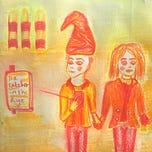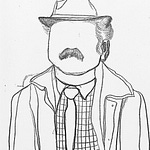Let me preface this issue by saying that I do not stan Mel Gibson.
I am not going to enter into an extended artist-versus-art semantic minefield, but I will say that I am not advocating that one supports people whose actions are dubious at best (@ Gibson’s extensive history of abuse, homophobia, racism, antisemitism, etc.). This piece is an unpacking of a character that he played and does not reflect my views on him at all.
This issue marks the first instalment in a series called The Intimacy Issues. The aim of this series is to provide insights into representations of love, admiration, and closeness that fall outside of the ‘normative’ understandings of intimacy (all within the sphere of media, course).
Some examples of the pieces of media I am going to use include The Night Manager, Vanilla Sky, Bladerunner 2049, and more, so get excited! I am also open to suggestions :)
That being said, let’s dive in.
Warning: Mentions of abuse, trauma, and Corona-time.
Conspiracy Theory was released in 1997 and stars Mel Gibson and Julia Roberts. Mel Gibson plays Jerry Fletcher, a conspiracy theorist cab driver who, enamoured and aided by the object of his affection, Alice Sutton (Roberts), sees his worst nightmares come true.
The film opens with a montage of him rattling off various conspiracy theories, warning the passengers of his cab of the dangers of fluoride in terms of its ability to ‘weaken your will’, new $100 bills containing tracking devices, and the fact that similar tracking devices in animals are one step away from tracking devices in our children. Watching this film 25 years after its release is eery given how the last two years have mired the world in mistrust and a pathological need to pick between the absolutist poles of total autonomy (see: anti-vaxxers, anti-maskers, COVID denialism, insurrection of various political motivations) and total obedience (see: the perpetuation of the moralisation of disease so that one is peer-pressured into feeling like a failure regardless of what steps you take to ensure safety thanks to a Twitter feed) in response to the chaos around us. You will find that many of Jerry Fletcher’s claims - or at least their constructions, in the more outlandish/dated examples - echo the walls of text that one can unearth from subreddits such as r/greatawakening and QAnon theories reposted to your aunt’s Facebook page.
Jerry Fletcher is a simple man. He never enters his apartment the same way twice. He likes talking to people. And he loves Alice Sutton more than anything else that this planet has to offer. After he retires his cab at the end of each day, he parks and watches Alice through binoculars, tuning the radio to whatever she mouths as she sweats her troubles away on her treadmill. The song that marks this film’s narrative is Franki Valli’s Can’t Take My Eyes off You. Every time I hear that song, I think of Jerry Fletcher.
Jerry’s experience of the world is characterised by ‘delusion’ and misunderstanding. Neurosis is arguably at its worst when paranoia proves itself warranted. You are scared that there is a spider lurking in some dark corner of your room, dismiss your anxieties as irrational, sweat yourself to sleep, and, upon waking up for a glass of water, discover said spider on the wall next to your bed. It feels as though you have been duped both by the cosmos and yourself. In Conspiracy Theory, Jerry finds himself in a similar situation, only on a much larger scale.
Jerry’s very being is fuelled by this neurosis. Apropos his never entering his apartment the same way twice (and many similar compulsions), he is convinced that they are out to get him. Whether their weapon is fluoride, pounds of killer beef, or federal agents, it is ready to be engaged for an attack at any moment, the enemy waiting to pounce, to destroy his freedom.
After he leaves Alice Sutton’s office at the Department of Justice, having given her the details of his latest conspiracy regarding satellite launches and earthquakes having emerged as a new conglomerate set on mass destruction, Jerry is kidnapped by men in dark suits and wakes up to a slew of torturous activities in an unfamiliar location. The torture is on account of a grain of truth that has been extracted from one of his seemingly ludicrous newsletters, and the fact that his exposure of this tidbit is dangerous to the operation to which these dark suits are tied. This sequence is harrowing, to say the least.
‘Who have you been talking to, Jerry?’
‘I don’t know. I drive a cab. I talk to lots of people.’
He is pressed for answers that he does not possess, and, upon escaping their talons and attempting - with great futility - to relay these happenings to Alice, blubbering with a gun in his hand, he is restrained and handcuffed to a hospital bed.
The rest of the movie plays out in a similar cat-and-mouse fashion, and I shan’t divulge all the details (for I highly recommend seeing them for yourself), but what I will say is that Jerry’s predicament speaks to the predicament of many lonely people in the present day, if only metaphorically for some.
Involuntary commitment to mental health facilities has hardly disappeared within the first fifth of this century. Nor has confinement as a whole, which has become a contentious and traumatic issue; whether people agree or disagree with the context of such confinements (and whether or not they are self-imposed or externally enforced), people are lonely. Their worlds are theirs and theirs alone. Jerry and others like him are the embodiment of such individualism and insularity.
Alice’s visit to Jerry’s apartment (after his elaborate escape from the hospital and death) is unnerving. His quirks - the placement of a beer bottle on his door handle, highly flammable wallpaper (in preparation for a swift escape that feels perpetually imminent), padlocked fridge, padlocked coffee kept inside of said fridge (to keep the beans fresh), newspaper clippings obscuring any and all surfaces, and myriad copies of The Catcher in the Rye - unsettle Alice in that she had believed that perhaps deep down, the level to which Jerry was misunderstood still fell within the parameters of ‘normality’. Of his Catcher in the Rye compulsion, he speaks of his need to purchase it every time he enters a shop, and, if it cannot be found within that particular shop, his need to source it elsewhere. Why? Because it makes him feel normal.
Gibson’s portrayal of Fletcher is over and above unhinged. The restless energy, the breathlessness that marks all of his interactions, the futility of words - their failure, how inexpressible they render their host in terms of his experiences - make for a memorable character, even if for some this is merely an example of a tired archetype: the Conspiracy Theorist. However, I think that the overwhelming amount of public fatigue in the face of such an individual is a chief reason to engage with this film. It allows the viewer to see the Conspiracy Theorist for what they are: a scared, lonely person, grasping at any and all straws to make meaning and sense of the chaotic world in which they live, as we all are.
We learn that Jerry was a subject in the MK Ultra program. Allow me to (briefly) infodump: Project MK Ultra was a highly unethical human experimentation program run by the CIA between 1953 and 1973. The goal of the project was to research and identify drugs that could potentially weaken individuals during interrogation. The forms of psychological and physical torture that subjects had to undergo included the forced ingestion of psychoactive drugs, electroshock treatment, hypnosis, sensory deprivation, and other forms of abuse. Upon hearing this, it makes more sense to the viewer that Jerry is a jittery mess with trouble expressing himself and remembering information that appears so simple for the average person to retain. Jerry is, after all, a trauma babe.
The only constant within his tumultuous universe is Alice. When Alice is in his apartment, she notices photorealistic drawings of her horse from her younger days, a creature Jerry noticed in a picture on her desk when visiting her office the day before. More significantly, when they make their escape via a quasi-trapdoor, Alice notices a rendering of her and her horse taking up the majority of the wall in the makeshift saferoom. She has no idea how Jerry has come to be in possession of such an image, nor does she have any idea of how much he truly knows about her. (Btw: I am not going to give it away.)
I believe that Jerry Fletcher’s obsession with Alice Sutton stands as a primary example of the insular nature of love in a crumbling world. His attempts at intimacy are primarily indirect, the 1997 equivalent to the multiple mini-Instagram-stalks so many of us carry out in the midst of an overwhelming crush. Their dynamic is also complicated, caught somewhere between a mutual saviour complex, a father-daughter guardianship, and romantic love. This complexity is heightened by the way in which Jerry’s feelings surface (i.e. the mini-stalks). He is hungry for knowledge about the woman with whom he is enamoured, just as he is hungry for knowledge about the latest and greatest top-secret espionage operations. And, because of his tenacity and skill, he can acquire it fairly easily.
If you need any more convincing, it is fair to say that this film has something for everyone: action (see: Jerry wheeling down a passage with his eyes taped open trying to escape from the bad guys), psychological intrigue (which involves everything I unpacked above, and more), and a relational arc that is far from a typical romance, but is as poignant, if not more so.
This movie is moving and takes some unexpected turns. Among the only things I can fault it for are its love theme (cliché and poorly used at times), and the fact that Mel Gibson is Not The Vibe in terms of his status as an actual person in the real world.
(I don’t think that my ratings are all that helpful in terms of gauging how enjoyable or engaging something is, as I enjoy most of the things that I watch to completion, but if I had to rate it, I would say 8,5/10).
Available on: Netflix.
This newsletter is also available on Medium and in audio form on Spotify.











Share this post